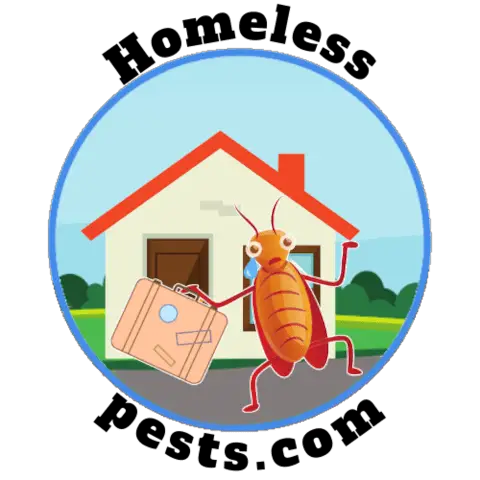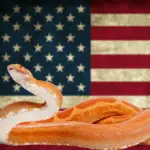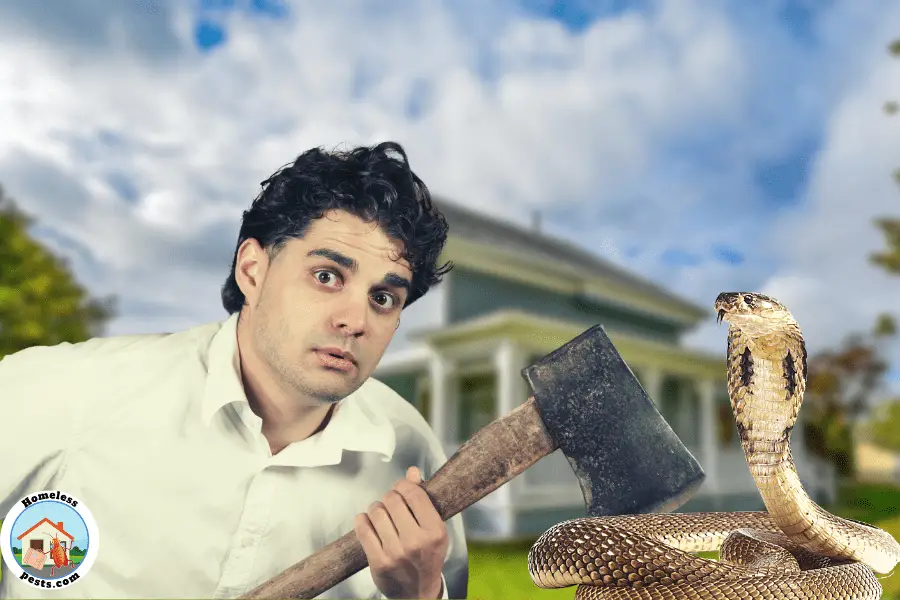Do you have a snake in your yard? You might not even know it! While snakes can be beneficial to the ecosystem, they can also be a nuisance when they take up residence in your yard.
Snakes often use holes to their advantage, burrowing down into the ground to create cozy homes or hunt for food. If you have a snake hole in your yard, it’s important to take steps to get rid of it before the snake moves in permanently.
Keep reading for tips on how to deal with snake holes in your yard.
How to Identify Snake Holes
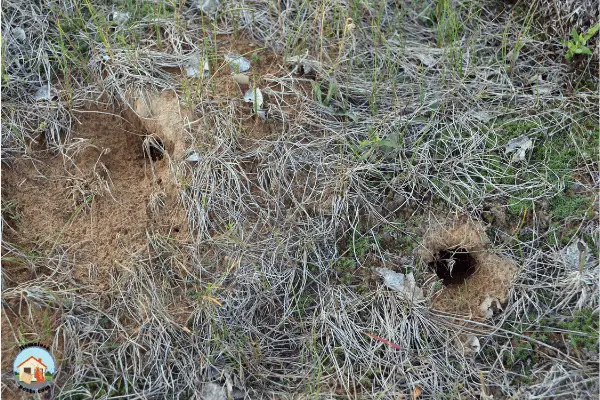
Lawns and backyards can be pockmarked by holes for a number of reasons, but quite often they are due to pests. Some of these critters can just be frustrating to deal with while others, such as snakes, can be downright dangerous.
A snake hole is easily distinguished by its diameter (usually less than a couple of inches) and lack of external paw or claw markings. These animals seek out seclusion, so you will often find their lairs under lumber or rock features. It’s unusual to see a collection of snake holes together and these are a sign of other pests.
Know your snakes
Now, to explain that a little further, if you want to quickly identify a snake hole, you need to understand the types of snakes you will likely find in your area (see my list below). Most snakes prefer dark and secluded areas, like piles of logs or rocks. So, if you come across a hole in the ground surrounded by these types of features, it is likely to be a snake hole.
Will a snake fit?
Also, look at the size and shape of the hole. As might be expected, most snakes make long, narrow tunnels underground with a diameter of 0.5 to 1 inch (1-2.5 cm). The whole length can vary depending on what type of snake made it – some snakes make tunnels as long as 3 feet (1 meter), while others only dig 6-10 inches (15-25 cm) long. However, you are probably going to have to decide based on what you can see from the outside.
Another good indication that you are dealing with a snake hole rather than a rodent burrow is the exterior of the hole. If there are no markings around the hole, such as paw prints or claw marks, there is a good chance a snake made it. Rabbit holes and other rodents are usually quite energetic when digging, so the spoil heap is going to be much more pronounced and dispersed.
How was the hole dug?
If you see two or more holes together in a group, those are probably not snake holes. For example, rabbits tend to create a warren for a group and will have multiple entrances. Snakes are quite solitary creatures and thus prefer to make their homes alone. This means that seeing one hole is usually a good sign that it is a snake hole.
That being said, many pests such as moles or gophers are also solitary, but their burrows are normally larger than that of a snake. So, if a hole looks too big for a snake but just about right for a mole, gopher or mouse or another small animal, it means you may have another animal living nearby that has made its home in your yard. They may not be as dangerous as a snake, but you still need to take action as they could still cause damage.
The shape of the hole
The shape of the hole can also give you some clues about who made it. If the hole is perfectly round, it was probably caused by a mammal and not by a snake.
So, the easiest thing you can do to identify a snake hole is to look at it. Probably if you live in an area where snakes are common, you’ve seen them and you could judge how small a hole they could fit in. If you can’t figure out by the size, the shape, and the appearance of the outside edges of the hole, it may be best to call a pest control specialist just to be safe.

How Can I Tell if a Snake Hole is Occupied or Vacant?
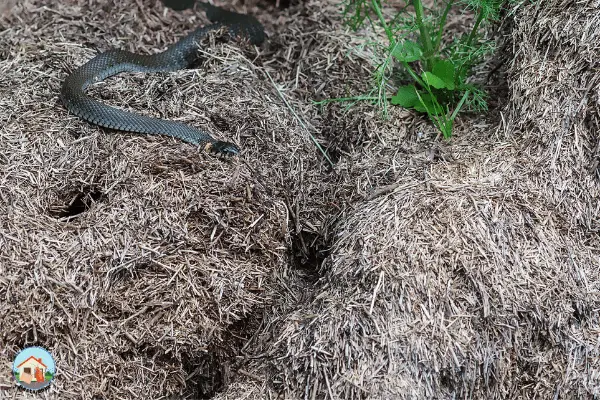
After you have identified that you definitely have a snake hole on your property, you will probably now want to know if the snake is still there.
There is no foolproof way to know unless you see the snake for yourself. Honestly, the best policy is to assume that there is a snake present and just proceed to the extermination phase.
However, the most common method of finding out is to place a stick or something similar into the hole and then wait to see what happens. If the rattlesnake comes out of its hole and strikes the stick, you have found your snake.
If you do not see anything happen after several minutes, it may be safe to assume that there is nothing currently there. It should be noted that snakes may take upwards of 10 minutes or more before they strike at something placed inside their holes.
Nevertheless, I’d really advise against ever sticking anything down a snake hole unless you are well protected and able to vacate the area in a hurry if needed.
Something to keep in mind is that snakes may be hibernating when it is cold outside. They may lie dormant for weeks or even months on end during these times. The best course of action is to avoid disturbing their hibernaculum (the area where they sleep). This will significantly increase your chances of being bitten if they are there.
What to Do if You Have Snakes in Your Yard?
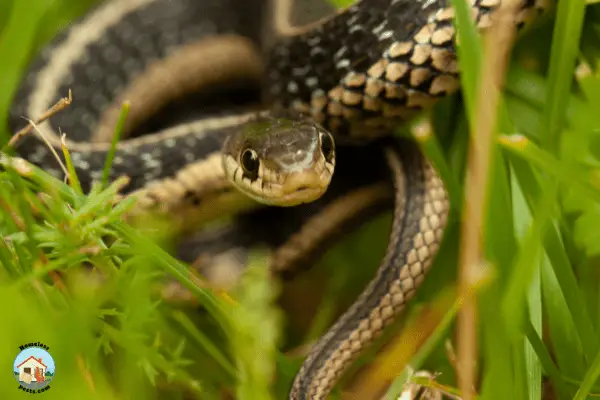
Snakes are a part of our ecosystem, so you can’t completely eradicate them from your property. But you can make your yard less attractive to snakes and create a barrier that will help prevent them from entering your home.
Garden maintenance
Keep your grass mowed, and weeds cut back. Snakes like to hide in tall grass and weeds, so it’s essential to keep these areas trimmed. When a snake arrives in an environment with little cover and nowhere to stalk prey, it won’t stay there for long.
Limit hiding places
Just with garden maintenance, those living in snake-infested areas need to really consider their landscaping and design features. Snakes love large rock-designed garden features and piles of firewood. If you can limit dark and damp hiding areas, you will limit the number of snakes present on your property.
Remove the source of food
Snakes arrive and stay in your backyard for one main reason, food. If you can eradicate the presence of rodents and amphibians along with other prey you will also remove your snake issue.
Don’t leave pet food outside as this will attract rats and mice, also avoid rodent accessible bird feeders if possible. Make sure you remove trash regularly and always store it in pest-proof trash cans.
Avoid using mulch
Stop adding mulch to your flower beds. A thick layer of mulch is more likely to attract snakes than loose soil or stones as they can burrow into it and hunt their prey. Although mulch is much better for your plants, you may wish to rethink your landscaping to avoid attracting these unwanted pests.
Protect your home
If there are snakes and other pests in your yard, they could eventually make it into your home. To avoid this, install a better door sweep on exterior doors or repair damaged screens. This will help keep snakes from entering your garage, shed, or home.
You’d be amazed at just how small a gap these critters can get into, so do a complete survey of your home to seal up these entrances.
Call in the cavalry
When the worst happens, call a professional pest control company that offers snake removal services if you suspect that you have a snake living in your yard (or home) already.
What Types of Snakes Might You Find in Your Yard (USA)?
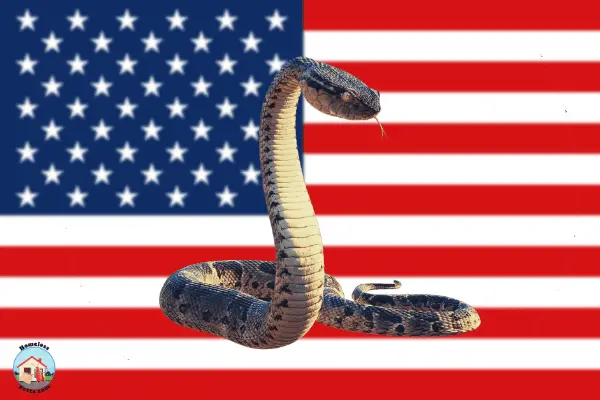
As I mentioned before, you can more easily identify a snake hole when you know what types of snakes live in your area. So, below you will find a list of common venomous species for each state in the USA. Please note, that there may be other species of snake not on the list, but these are either non-venomous or are escaped pet species.
To identify a snake you’ve seen, check out my full list of American snake species with a picture of over 130 venomous and non-venomous species.
Alabama
- Copperhead
- Cottonmouth
- Massasauga
- Pygmy Rattlesnake
- Timber Rattlesnake
Alaska
– No native species
Arizona
- Arizona Black Rattlesnake
- Black-Tailed Rattlesnake
- Grand Canyon Rattlesnake
- Massasauga
- Mojave Rattlesnake
- Prairie Rattlesnake
Arkansas
- Copperhead
- Cottonmouth
- Pygmy Rattlesnake
- Timber Rattlesnake
- Western Diamondback Rattlesnake
California
- Great Basin Rattlesnake
- Mojave Rattlesnake
- Northern Pacific Rattlesnake
- Panamint Rattlesnake
- Red Diamond Rattlesnake
- Sidewinder
Colorado
- Massasauga
- Midget Faded Western Rattlesnake
- Mojave Rattlesnake
- Prairie Rattlesnake
Connecticut
- Copperhead
- Timber Rattlesnake
Delaware
- Copperhead
- Timber Rattlesnake
Florida
- Copperhead
- Cottonmouth
- Massasauga
- Pygmy Rattlesnake
- Timber Rattlesnake
Georgia
- Copperhead
- Cottonmouth
- Massasauga
- Pygmy Rattlesnake
- Timber Rattlesnake
Hawaii
– No native species and snake ownership is currently illegal
Idaho
- Prairie Rattlesnake
Illinois
- Copperhead
- Cottonmouth
- Massasauga
- Timber Rattlesnake
Indiana
- Copperhead
- Cottonmouth
- Massasauga
- Timber Rattlesnake
Iowa
- Copperhead
- Massasauga
- Prairie Rattlesnake
- Timber Rattlesnake
Kansas
- Copperhead
- Cottonmouth
- Massasauga
- Prairie Rattlesnake
- Pygmy Rattlesnake
- Timber Rattlesnake
Kentucky
- Copperhead
- Cottonmouth
- Pygmy Rattlesnake
- Timber Rattlesnake
Louisiana
- Copperhead
- Cottonmouth
- Eastern Diamondback Rattlesnake
- Pygmy Rattlesnake
- Timber Rattlesnake
Maine
-No venomous native species
Maryland
- Copperhead
- Timber Rattlesnake
Massachusetts
- Copperhead
- Timber Rattlesnake
Michigan
- Massasauga
Minnesota
- Massasauga
- Timber Rattlesnake
Mississippi
- Copperhead
- Cottonmouth
- Eastern Diamondback Rattlesnake
- Pygmy Rattlesnake
- Timber Rattlesnake
Missouri
- Copperhead
- Cottonmouth
- Massasauga
- Pygmy Rattlesnake
- Timber Rattlesnake
Montana
- Prairie Rattlesnake
Nebraska
- Copperhead
- Massasauga
- Prairie Rattlesnake
- Timber Rattlesnake
Nevada
- Great Basin Rattlesnake
- Panamint Rattlesnake
- Prairie Rattlesnake
- Sidewinder
- Speckled Rattlesnake
- Western Diamondback Rattlesnake
New Hampshire
- Timber Rattlesnake
New Jersey
- Copperhead
- Timber Rattlesnake
New Mexico
- Rattlesnake
- Massasauga
- Prairie Rattlesnake
- Ridge-Nosed Rattlesnake
- Rock Rattlesnake
- Western Diamondback Rattlesnake
New York
- Copperhead
- Massasauga
- Timber Rattlesnake
North Carolina
- Copperhead
- Cottonmouth
- Eastern Diamondback Rattlesnake
- Pygmy Rattlesnake
- Timber Rattlesnake
North Dakota
- Prairie Rattlesnake
Ohio
- Copperhead
- Massasauga
- Timber Rattlesnake
Oklahoma
- Copperhead
- Cottonmouth
- Massasauga
- Prairie Rattlesnake
- Pygmy Rattlesnake
- Timber Rattlesnake
Oregon
- Northern Pacific Rattlesnake
- Prairie Rattlesnake
Pennsylvania
- Copperhead
- Massasauga
- Timber Rattlesnake
Rhode Island
-No venomous native species
South Carolina
- Copperhead
- Cottonmouth
- Eastern Diamondback Rattlesnake
- Pygmy Rattlesnake
South Dakota
- Prairie Rattlesnake
Tennessee
- Copperhead
- Cottonmouth
- Pygmy Rattlesnake
- Timber Rattlesnake
Texas
- Black-Tailed Rattlesnake
- Copperhead
- Cottonmouth
- Massasauga
- Mojave Rattlesnake
- Prairie Rattlesnake
Utah
- Great Basin Rattlesnake
- Midget Faded Western Rattlesnake
- Mojave Rattlesnake
- Prairie Rattlesnake
- Sidewinder
- Speckled Rattlesnake
Vermont
- Timber Rattlesnake
Virginia
- Copperhead
- Cottonmouth
- Timber Rattlesnake
Washington
- Northern Pacific Rattlesnake
- Prairie Rattlesnake
West Virginia
- Copperhead
- Timber Rattlesnake
Wisconsin
- Massasauga
- Timber Rattlesnake
Wyoming
- Midget Faded Western Rattlesnake
- Prairie Rattlesnake
District of Columbia
-No venomous native species
How to Humanely Prevent Snakes in Your Yard
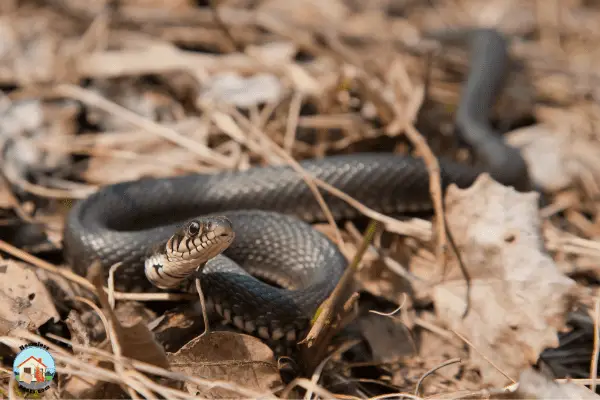
Snakes tend to take up residence in yards where they have access to food, water, and shelter. By removing these basic necessities, you have an excellent way of keeping them away.
Here are some things you can do:
- Cut down tall brush and grass – Snakes like to hide in these areas.
- Remove debris piles – These provide shelter and food for the snakes.
- Keep lawns mowed – Low growth limits hiding places for snakes.
- Keep bird feeders away from the house – The seed attracts rodents that snakes eat.
- Use live snake traps
- Call an exterminator to catch the live snake
How to Stop Snakes from Getting Into Your House
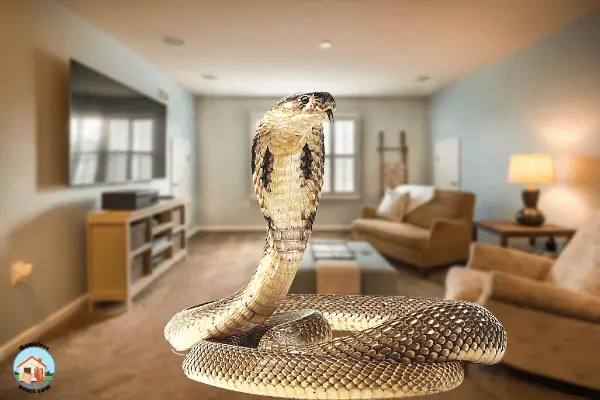
Snakes are primarily attracted to your home because of their food sources. These may be rodents, pets, or other small animals. They may also be drawn indoors if they come seeking warmth and cover from extreme weather conditions or during hibernation.
So, the first step is really to eliminate any rodents, frogs, and other snake snacks which may want to take shelter in your home. The first step would be to avoid them taking up residence in your yard, as well as preventing them from entering your home.
If you have a bird feeder in your yard, you should remove it as this may attract rodents. Alternatively, get a rodent-proof one. Ensure that any garbage bins are securely closed and that there is no standing water near your home, which could attract frogs and other small animals that snakes feed on.
The best way to keep snakes out of your home is to make sure you don’t have any places for them to hide in, around, or under your house.
This can be done by:
- Keeping shrubs and tree branches trimmed and away from your home.
- Sealing cracks, crevices, and holes around the foundation, vents, and windows.
- Installing weather stripping around doors.
- Moving firewood piles away from the house and stacking wood neatly so snakes can’t hide underneath it.
- Removing debris from around your yard that could be used as a hiding place for snakes.
In the home, target a snake’s prey by:
- Keeping your home clean and tidy as well as free of any crumbs for rodents to eat
- Keeping all food in sealed plastic containers
- Setting traps and removing live or dead rodents (Snakes won’t eat dead prey)
What Habitats Do Snakes Like?
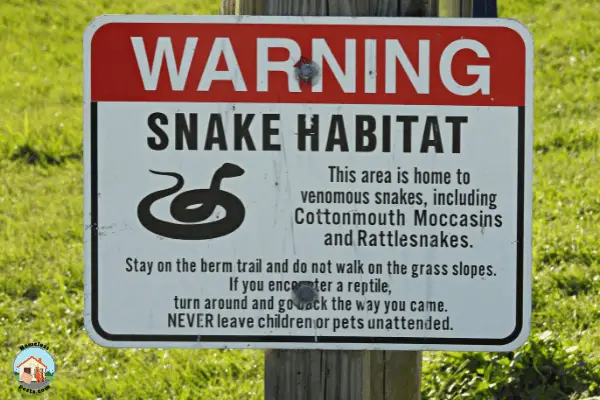
Many different types of snakes like to call backyards home. Each snake has its own unique needs and preferences. The factors you should be most aware of when considering your backyard include:
Shelter and Shade: Most snakes prefer to live in places where they can hide from predators and the dangers associated with direct sunlight.
Cover: The ideal areas for snakes will have lots of concealment. This could include tall grasses, heavy undergrowth, or dense vegetation. Snakes like to hide and sleep inside plants, branches, or leaves to stay calm and safe during the day but it also offers a great hunting ground.
Food Source: Snakes like to live in places where there are a lot of small animals for them to eat. If you’ve noticed a lot of rodent activity you will more than likely experience a snake issue too.
Water Sources: All snakes require a water source to survive. However, on your property, it will be the water needed by prey that is most important. if you have water features that attract its prey, a snake will be happy to stick around.
Warm climates: Snakes like to be warm as they are cold-blooded and you will likely have more species of snake in warmer US states (Alaska has no native species for example). Snake activity will be severely limited during the winter months.

Final thoughts
So what do you do if you think you have a snake problem on your property? The best option is to call a professional exterminator. You can find call one of our nationwide pest control partners by clicking here. They will be able to help identify the type of snake and provide the necessary treatment to get rid of them.
If you want to try to take care of the snakes yourself, remember that they can be extremely dangerous, so be extra cautious if you’re going to attempt to remove them from your property. Stay safe and don’t hesitate to reach out for help if needed!
